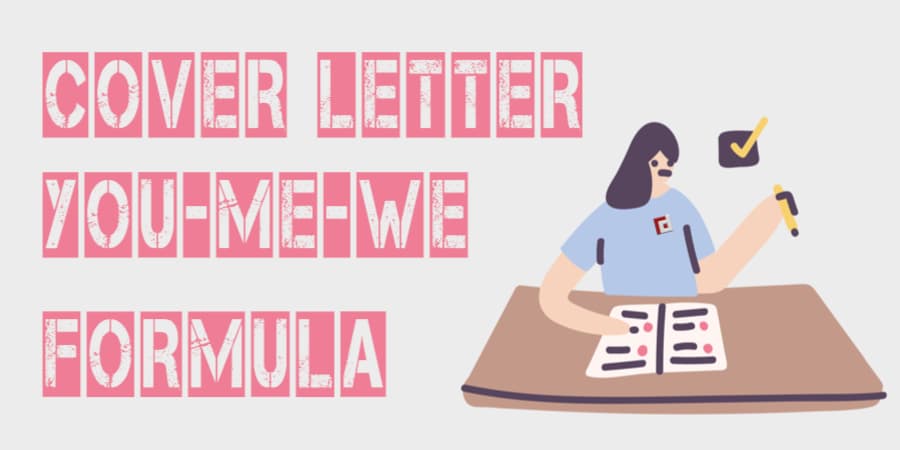from one of the top Recruitment Agency & Outsourcing Company in Thailand & Indonesia
You-Me-We Formula : Ingenious Cover Letter build-up tip
- Tags:
- Resume / CV

For many, the cover letter in an application is the hardest part. What is the correct structure for the application letter? The You-Me-We formula is good support for getting the important messages across. With it, you give your application a clear structure that will convince HR professionals. What the You-Me-We formula includes and how you can use it for your cover letter can be found here.
What is the You-Me-We formula?
"You, Me, We" stands for "You, I, we" The You-Me-We formula serves as an orientation aid to build up the content structure of an application letter in a meaningful way. To understand how to use them, let's explain the structure and content of a cover letter.
Structure of a cover letter
The cover letter for an application contains the following components: letterhead, introduction, main part, company reference, concluding part (including greeting), attachments.
Whenever possible, the whole thing should not be longer than an A4 page. The following graphic shows the structure of an application:
Formal elements
The following two components are pure formalities that allow an assignment. Components are:
Letterhead:
Be careful to avoid typing errors or outdated information. These happen quickly if your own mobile phone number changes or you simply use an old template:
Sender: Enter your contact details (full name, address, telephone number, email address) here.
Recipient: This is the company name, contact person, and company headquarters
Date: Write the current date (preferably the date of dispatch) right-justified under the recipient.
Subject: Aligned to the left, it continues with the subject line. Here you write "Application as/for..."
Salutation
Often you can already see from the job description who you need to address your letter to. If this is not the case, we recommend researching the contact person. An impersonal form of address, "Dear Sir or Madam…" seems rather careless.
Content of a cover letter
To give the cover letter a meaningful structure, integrate the You-Me-We formula as follows:
Introduction: You
This is about the company and what attracts you to it. HR professionals only take an average of two minutes to read an application. The trick is to make the cover letter interesting. The biggest mistake here: You start with a phrase. Instead, demonstrate that the company will benefit if they choose you. You are welcome to establish a company reference here - for example, refer to a previous phone call or a meeting at the job fair. In any case, your enthusiasm for this company and this job must be evident in this opening sentence.
Main part: Me
This section is about you. Self-marketing and soft skills are required. A typical mistake: applicants only list their competencies. But that doesn't seem very convincing. Please demonstrate your ability to work in a team, for example, by giving examples: "As a member of a five-person team, I made a decisive contribution to ..." you mustn't refer to any skills and competencies at random: the reference to the job should be clear emerge from it.
Company reference: (You & Me)
The company connection is part of the main part. We emphasize it, however, because otherwise, this point is easily lost. At this point in the letter, you plausibly explain how you and your knowledge contribute to helping the company with its challenges. This requires an intensive examination of the respective position in advance. At the same time, you must self-critically compare which of the must and can qualifications you have.
Final part: We
You Me = We. Ultimately, that is the successful implementation of the You-Me-We formula. You end your letter with a final sentence with which you look positively into the future. Usually, by expressing your joy at an interview. Do not use the subjunctive (would, could) to make you seem unnecessarily insecure. Optionally, you can also include your salary expectations (if required) and a note about your earliest possible start.
If you were able to present the previous points understandably, this also results in the "we" for the HR manager. You are then guaranteed an invitation to an interview.
What else should you watch out for besides the You-Me-We formula?
The You-Me-We formula is also suitable for speculative applications and letters of motivation. In addition to this support, there are three other important points to consider so that you are convincing:
error
It is important to avoid spelling and grammatical errors. Ideally, have your application proofread.
layout
Pay attention to a harmonious overall picture. This includes that you should not use more than two different fonts (for reasons of design) in your application. Arial and Times New Roman are popular. You should also use other design elements sparingly, such as color, bold, and italic type. First of all, it looks a bit restless otherwise. Second, you create the impression that you are putting different documents together into a whole. Your cover letter should also be easy to read. You can do this with 12-point font size. For reasons of space, you can reduce it to 11 points. Important: When writing your résumé, in particular, ensure that you adhere to the font size you have chosen for headings and body text.
style
Long nested sentences are hard to read. It is better to write short sentences. There is an easy trick to check yourself: read your cover letter to yourself. This is beneficial in several ways. So you still notice duplications or mistakes. And also cumbersome formulations. Passive sentences have the disadvantage that they force the author into a supporting role. However, if the subject (ideally you) is known, you should also name him. For example: "The tasks were always done on time." Instead, the active formulation: "I always kept the deadlines."
